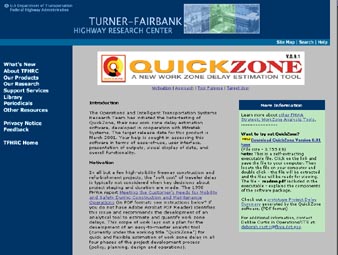U.S. Department of Transportation
Federal Highway Administration
1200 New Jersey Avenue, SE
Washington, DC 20590
202-366-4000
Focus
| Accelerating Infrastructure Innovations |
Publication Number: FHWA-RD-01-062
Date: March 2001
The prototype version of QuickZone, a new work zone delay estimation software developed by the Federal Highway Administration (FHWA) and Mitretek Systems, is now available for use and assessment by highway agencies. One State getting ready to give it a real-world tryout is Maryland.
"We had an ongoing project with the University of Maryland where we were looking at capacity in work zones and trying to come up with a tool for estimating queues and delays," says Jawad Paracha of the Maryland State Highway Administration (SHA). "When we found out about QuickZone, we decided to combine the two efforts."
QuickZone, which is the first product to come out of FHWA's new strategic Work Zone Analysis Tools (SWAT) program (see July/August 2000 Focus), can be used to compare the traffic impacts for work zone mitigation strategies and estimate the costs associated with these impacts. The costs can be estimated for both an average day of work and for the whole life cycle of construction. The software, says lead developer Karl Wunderlich of Mitretek Systems, "will help highway agencies better phase and stage their construction activities. It can help them determine what times of day and what times of the year are best for a certain project, for example."
QuickZone's open source code has allowed the University of Maryland, under contract with SHA, to customize the program to better meet the State's needs. The university, for example, has added its own capacity estimation model to the program. In Maryland's version of the program, users can also define the criteria that will be used for analysis, such as setting a maximum allowable queue of vehicles or length of delay. And the Maryland version uses a 24-hour traffic count, instead of the average daily traffic count found in the standard program.
Maryland's version of QuickZone is scheduled to be ready this month. Copies will be distributed to all of the State's district traffic engineers so that they can perform validation testing and use it for general analysis. "We believe that the program can guide the engineers in the right direction and provide a more accurate estimation of delays and queues," says Paracha.

A user need only have Microsoft Excel 97 or higher running on a Windows-based PC to use the QuickZone application. Version 0.91 can be downloaded from the Web at www.tfhrc.gov/its/quickzon.htm. Version 0.99 of the prototype is due out in April, while Version 1.0 of the software is scheduled to be released in the fall of 2001. For more information on the software, contact Deborah Curtis at FHWA, 202-493-3267 (fax: 202-493-3419; email: deborah.curtis@fhwa.dot.gov). For more information on the Maryland version of QuickZone, contact Jawad Paracha at the Maryland SHA, 410-787-5891 (jparacha@sha.state.md.us).
FHWA is encouraging other States to customize QuickZone for their own use through its QuickZone Partnership Program. The partnership program will take advantage of QuickZones's open source code as a means of further improving the software and providing State and local agencies with a tool that best meets their needs. If you are interested in participating in the partnership program, please contact Matthew Hardy at Mitretek Systems, 202-863-2982 (email: matthew.hardy@mitretek.org).